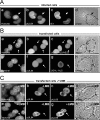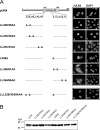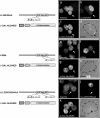Human cytomegalovirus UL84 protein contains two nuclear export signals and shuttles between the nucleus and the cytoplasm
- PMID: 17005707
- PMCID: PMC1617278
- DOI: 10.1128/JVI.00995-06
Human cytomegalovirus UL84 protein contains two nuclear export signals and shuttles between the nucleus and the cytoplasm
Abstract
Previous studies defined pUL84 of human cytomegalovirus as an essential regulatory protein with nuclear localization that was proposed to act during initiation of viral-DNA synthesis. Recently, we demonstrated that a complex domain of 282 amino acids within pUL84 functions as a nonconventional nuclear localization signal. Sequence inspection of this domain revealed the presence of motifs with homology to leucine-rich nuclear export signals. Here, we report the identification of two functional, autonomous nuclear export signals and show that pUL84 acts as a CRM-1-dependent nucleocytoplasmic shuttling protein. This suggests an unexpected cytoplasmic role for this essential viral regulatory protein.
Figures




Similar articles
-
A novel transferable nuclear export signal mediates CRM1-independent nucleocytoplasmic shuttling of the human cytomegalovirus transactivator protein pUL69.EMBO J. 2001 Dec 17;20(24):7271-83. doi: 10.1093/emboj/20.24.7271. EMBO J. 2001. PMID: 11743003 Free PMC article.
-
A methionine-rich domain mediates CRM1-dependent nuclear export activity of Borna disease virus phosphoprotein.J Virol. 2006 Feb;80(3):1121-9. doi: 10.1128/JVI.80.3.1121-1129.2006. J Virol. 2006. PMID: 16414989 Free PMC article.
-
The redox state of SECIS binding protein 2 controls its localization and selenocysteine incorporation function.Mol Cell Biol. 2006 Jul;26(13):4895-910. doi: 10.1128/MCB.02284-05. Mol Cell Biol. 2006. PMID: 16782878 Free PMC article.
-
Leucine-rich nuclear-export signals: born to be weak.Trends Cell Biol. 2005 Mar;15(3):121-4. doi: 10.1016/j.tcb.2005.01.005. Trends Cell Biol. 2005. PMID: 15752974 Review.
-
Interactions of human cytomegalovirus proteins with the nuclear transport machinery.Curr Top Microbiol Immunol. 2008;325:167-85. doi: 10.1007/978-3-540-77349-8_10. Curr Top Microbiol Immunol. 2008. PMID: 18637506 Review.
Cited by
-
Viral Subversion of the Chromosome Region Maintenance 1 Export Pathway and Its Consequences for the Cell Host.Viruses. 2023 Nov 6;15(11):2218. doi: 10.3390/v15112218. Viruses. 2023. PMID: 38005895 Free PMC article. Review.
-
Human cytomegalovirus UL84 interacts with an RNA stem-loop sequence found within the RNA/DNA hybrid region of oriLyt.J Virol. 2007 Jul;81(13):7077-85. doi: 10.1128/JVI.00058-07. Epub 2007 Apr 25. J Virol. 2007. PMID: 17459920 Free PMC article.
-
The IE2 60-kilodalton and 40-kilodalton proteins are dispensable for human cytomegalovirus replication but are required for efficient delayed early and late gene expression and production of infectious virus.J Virol. 2007 Mar;81(6):2573-83. doi: 10.1128/JVI.02454-06. Epub 2007 Jan 3. J Virol. 2007. PMID: 17202222 Free PMC article.
-
Interaction of HCMV UL84 with C/EBPalpha transcription factor binding sites within oriLyt is essential for lytic DNA replication.Virology. 2009 Sep 15;392(1):16-23. doi: 10.1016/j.virol.2009.06.035. Epub 2009 Jul 23. Virology. 2009. PMID: 19631360 Free PMC article.
-
Dynamic and nucleolin-dependent localization of human cytomegalovirus UL84 to the periphery of viral replication compartments and nucleoli.J Virol. 2014 Oct;88(20):11738-47. doi: 10.1128/JVI.01889-14. Epub 2014 Jul 30. J Virol. 2014. PMID: 25078694 Free PMC article.
References
-
- Boehmer, P. E., M. S. Dodson, and I. R. Lehman. 1993. The herpes simplex virus type-1 origin binding protein. DNA helicase activity. J. Biol. Chem. 268:1220-1225. - PubMed
-
- Bruckner, R. C., J. J. Crute, M. S. Dodson, and I. R. Lehman. 1991. The herpes simplex virus 1 origin binding protein: a DNA helicase. J. Biol. Chem. 266:2669-2674. - PubMed
-
- Colletti, K. S., Y. Xu, I. Yamboliev, and G. S. Pari. 2005. Human cytomegalovirus UL84 is a phosphoprotein that exhibits UTPase activity and is a putative member of the DExD/H box family of proteins. J. Biol. Chem. 280:11955-11960. - PubMed
-
- Dodson, M. S., and I. R. Lehman. 1993. The herpes simplex virus type I origin binding protein. DNA-dependent nucleoside triphosphatase activity. J. Biol. Chem. 268:1213-1219. - PubMed
Publication types
MeSH terms
Substances
LinkOut - more resources
Full Text Sources

